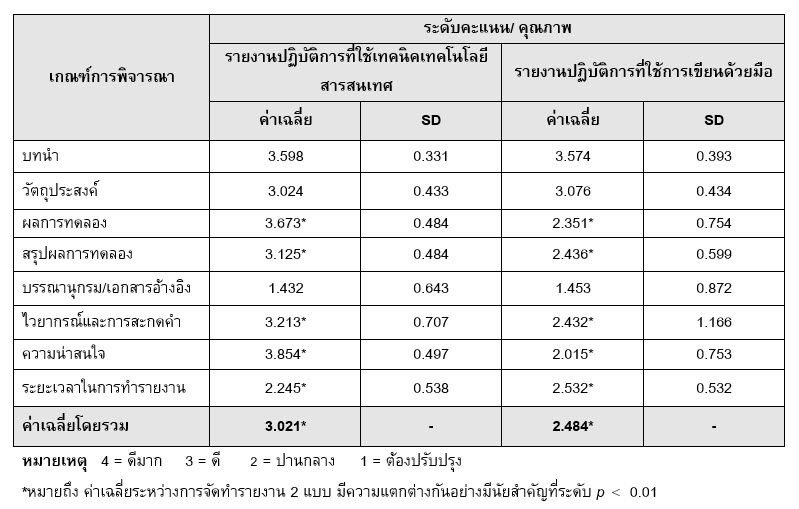การเพิ่มประสิทธิภาพการเขียนรายงานปฏิบัติการด้วยเทคนิคทางเทคโนโลยีสารสนเทศในวิชาจุลินทรีย์อุตสาหกรรม
Main Article Content
Abstract
Arun Chanchaichaovivat
รับบทความ: 15 เมษายน 2553; ยอมรับตีพิมพ์: 12 พฤษภาคม 2553
บทคัดย่อ
การวิจัยนี้มีวัตถุประสงค์เพื่อประเมินและเปรียบเทียบรูปแบบของการนำเสนอรายงานปฏิบัติการวิชาจุลินทรีย์อุตสาหกรรมของนิสิตสาขาวิชาเทคโนโลยีการอาหาร 2 กลุ่ม คือกลุ่มที่ใช้เทคโนโลยีสารสนเทศช่วยจัดทำ เปรียบเทียบกับกลุ่มที่เขียนรายงานด้วยลายมือ รวมทั้งวิเคราะห์ความคิดเห็นนิสิตชั้นปีที่ 1 คณะวิทยาศาสตร์และเทคโนโลยี มหาวิทยาลัยราชภัฏบ้านสมเด็จเจ้าพระยา เกี่ยวกับความสำคัญของเทคโนโลยีสารสนเทศกับการเขียนรายงานปฏิบัติการ เครื่องมือที่ใช้ในการวิจัย ได้แก่แบบประเมินรายงานปฏิบัติการ แบบประเมินการจัดการเรียนการสอน และแบบสอบถามความคิดเห็น ผลการวิจัยพบว่ารายงานของนิสิตกลุ่มที่ใช้เทคโนโลยีสารสนเทศมาช่วยจัดทำรายงานมีผลการประเมินในภาพรวมอยู่ในระดับดี สำหรับรายงานที่เขียนด้วยลายมือได้รับผลการประเมินในภาพรวมอยู่ในระดับปานกลาง และรายงานของทั้งสองกลุ่มต้องปรับปรุงในส่วนของข้อมูลบรรณานุกรมหรือเอกสารอ้างอิง ในด้านการจัดการเรียนการสอนให้กับนิสิตสองกลุ่มนี้ พบว่ากลุ่มที่ใช้เทคโนโลยีสารสนเทศจัดทำรายงานมีองค์ประกอบด้านผู้สอน ด้านเนื้อหา ด้านสื่อและสิ่งสนับสนุนการเรียนการสอนอยู่ในระดับดีมาก โดยมีองค์ประกอบด้านผู้เรียนได้คะแนนอยู่ในระดับต่ำกว่าองค์ประกอบอื่น สำหรับกลุ่มที่จัดทำรายงานด้วยการเขียนลายมือมีเพียงองค์ประกอบเดียวที่ได้คะแนนเฉลี่ยอยู่ในระดับดีมากคือด้านผู้สอน โดยที่ด้านกิจกรรมการเรียนการสอนได้ระดับคะแนนต่ำกว่าองค์ประกอบอื่น ผลการวิเคราะห์ความคิดเห็นเกี่ยวกับความสำคัญของเทคโนโลยีสารสนเทศกับการเขียนรายงานปฏิบัติการของนิสิตชั้นปีที่ 1 คณะวิทยาศาสตร์และเทคโนโลยี จำนวน 200 คน พบว่านิสิตเห็นด้วยค่อนข้างมากกับการจัดทำรายงานโดยใช้ความรู้และอุปกรณ์ด้านเทคโนโลยีสารสนเทศ อุปกรณ์ที่นิสิตเห็นด้วยค่อนข้างมากในการนำมาใช้จัดทำรายงาน ได้แก่ แฮนดีไดรฟ์ (handy drive) กล้องดิจิตอล (digital camera) และเครื่องพิมพ์ผล (printer) รวมทั้งนิสิตเห็นด้วยข้างมากกับการจัดการกับข้อมูลให้อยู่ในรูปของไฟล์อิเล็กทรอนิกส์ (electronic file) โดยนิสิตรู้สึกเฉยๆ กับการใช้โทรศัพท์มือถือมาช่วยจัดทำรายงาน จากผลการวิจัยทำให้สามารถสรุปได้ว่าการนำความรู้ทางด้านเทคโนโลยีสารสนเทศมาใช้ในการเรียนการสอนทางด้านวิทยาศาสตร์มีความสำคัญและนิสิตยอมรับในเทคนิคเหล่านี้ ดังนั้นผู้สอนจึงควรเรียนรู้เรื่องของการจัดกระทำข้อมูลโดยใช้เทคโนโลยีสารสนเทศเพิ่มมากขึ้นและควรนำมาประยุกต์ใช้กับการเรียนการสอนในยุคปัจจุบัน
คำสำคัญ: เทคโนโลยีสารสนเทศ รายงานปฏิบัติการ คณะวิทยาศาสตร์และเทคโนโลยี มหาวิทยาลัยราชภัฏบ้านสมเด็จเจ้าพระยา
Abstract
The research objectives were to evaluate and compare two laboratory report patterns written by Food Science and Technology students in Microbiology course. First group of students was assigned to do laboratory report with information technology technique (ITT) and the second group used hand writing. The research tools were laboratory scoring rubric, teaching and learning evaluation form, and students’ opinion questionnaire. The results showed that laboratory report used ITT was in good quality, whereas hand-writing report (HWR) was moderate. Both groups have to improve the reference parts of their reports. Teaching and learning evaluation of ITT group showed very good level in four factors, i.e., instructor, contents, media, and teaching and learning facilities. Student factor in ITT group was acquired the lowest score. Teaching and learning of HWR class presented very good level in instructor component, but teaching and learning activities was at the lowest score. Agreement analysis of 200 first year students from Faculty of Science and Technology showed that they were about most agreed in doing laboratory report with ITT and using ITT tools (handy drive, digital camera, and printer). Moreover, they were about most acceptable in providing electronic file report. They were unconcerned with using mobile phone for doing laboratory report. By these results, ITT seemed to be important facilitated tool for science education and it was concurrent from students. Therefore, instructors should apply ITT to their class activities to improve teaching and learning outcomes.
Keywords: Information Technology; Laboratory Report; Faculty of Science and Technology; Bansomdejchaopraya Rajabhat University
Downloads
Article Details

This work is licensed under a Creative Commons Attribution-NonCommercial 4.0 International License.
References
กษิติธร ภูภราดัย และสิรินทร ไชยศักดา. (2546). กรอบแนวคิดและความเป็นมาของความเหลื่อมล้ำในการเข้าถึงสารสนเทศและความรู้. Retrieved July 20, 2009, from http://www.nitc.go.th/database/digital_divide.pdf
ครรชิต มาลัยวงศ์. (2542). การพัฒนาการเรียนรู้ตลอดชีวิต. Retrieved August 15, 2009, from http://ite.nectec.or.th/drkanchit/books/articles/lifelearn.pdf
ธนกร หวังพิพัฒน์วงศ์. (2552). การประยุกต์ไอซีทีเพื่อการ ศึกษา. Retrieved December 2, 2009, from http://www.bu.ac.th/knowledgecenter/epaper/ july_dec2004/thanakorn.pdf
ทิศนา แขมมณี. (2545). ศาสตร์การสอน: องค์ความรู้เพื่อการจัดกระบวนการเรียนรู้ที่มีประสิทธิภาพ. กรุงเทพฯ: จุฬาลงกรณ์มหาวิทยาลัย.
บุญเรียง ขจรศิลป์. (2534). วิธีวิจัยทางการศึกษา. พิมพ์ครั้งที่ 3. กรุงเทพฯ: พิชาญพริ้นติ้ง.
Alavi, M. (1994). Computer-mediated collaborative learning: An empirical evaluation. MIS Quarterly, 18 (2), 150-174.
Anastasisdes, P.S. (2002). Virtual universities: A critical approach. Comp. Educ., 1170-1171.
Bruner, J. S. (1960). The process of education. Cambridge: Harvard University Press. Career and Alternative Education. 2006. Lab Report Rubric. Retrieved June 25, 2009, from http://rop.mercedlearn.org/
Dewey, J. (1938). Experience and Education. New York: Kappa Delta Pi.
Farrel, G. M., ed. (2001). The Changing Faces of Virtual Education. Columbia: The Commonwealth of Learning.
Haddad, W. D., ed. (2002). Technologies for Education. Washington, DC: Academy for Educational Development.
Hiroshi, K. and Shintaro, I. (1999). Web tools for distance learning. Systems, Man, and Cybernetics, 235-238.
Jewels, T., Heredero, P.C., and Cambell, M. (2004). Does technology impact on teaching styles or do teaching styles impact on technology in the delivery of higher education? J. Issues Information Technol., 1, 79-95.
Resta, P., ed. (2002). Information and communication technologies in teacher education. Division of Higher Education.
